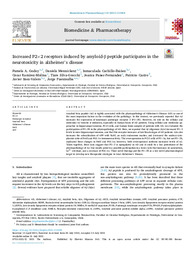Por favor, use este identificador para citar o enlazar este ítem:
https://hdl.handle.net/11000/31209Registro completo de metadatos
| Campo DC | Valor | Lengua/Idioma |
|---|---|---|
| dc.contributor.author | Godoy, Pamela A. | - |
| dc.contributor.author | Mennickent, Daniela | - |
| dc.contributor.author | Cuchillo‑Ibañez, Inmaculada | - |
| dc.contributor.author | Ramirez Molina, Oscar | - |
| dc.contributor.author | Silva-Grecchi, Tiare | - |
| dc.contributor.author | Panes Fernandez, Jessica | - |
| dc.contributor.author | Castro, Patricio | - |
| dc.contributor.author | Sáez-Valero, Javier | - |
| dc.contributor.author | Fuentealba, Jorge | - |
| dc.date.accessioned | 2024-02-07T10:22:40Z | - |
| dc.date.available | 2024-02-07T10:22:40Z | - |
| dc.date.created | 2021-07-31 | - |
| dc.identifier.citation | Biomed Pharmacother. 2021 Oct:142:111968 | es_ES |
| dc.identifier.issn | 1950-6007 | - |
| dc.identifier.issn | 0753-3322 | - |
| dc.identifier.uri | https://hdl.handle.net/11000/31209 | - |
| dc.description.abstract | Amyloid beta peptide (Aβ) is tightly associated with the physiopathology of Alzheimer’s Disease (AD) as one of the most important factors in the evolution of the pathology. In this context, we previously reported that Aβ increases the expression of ionotropic purinergic receptor 2 (P2×2R). However, its role on the cellular and molecular Aβ toxicity is unknown, especially in human brain of AD patients. Using cellular and molecular approaches in hippocampal neurons, PC12 cells, and human brain samples of patients with AD, we evaluated the participation of P2×2R in the physiopathology of AD. Here, we reported that Aβ oligomers (Aβo) increased P2×2 levels in mice hippocampal neurons, and that this receptor increases at late Braak stages of AD patients. Aβo also increases the colocalization of APP with Rab5, an early endosomes marker, and decreased the nuclear/cytoplasmic ratio of Fe65 and PGC-1α immunoreactivity. The overexpression in PC12 cells of P2×2a, but not P2×2b, replicated these changes in Fe65 and PGC-1α; however, both overexpressed isoforms increased levels of Aβ. Taken together, these data suggest that P2×2 is upregulated in AD and it could be a key potentiator of the physiopathology of Aβ. Our results point to a possible participation in a toxic cycle that increases Aβ production, Ca2+ overload, and a decrease of PGC-1α. These novel findings put the P2×2R as a key novel pharmacological target to develop new therapeutic strategies to treat Alzheimer’s Disease. | es_ES |
| dc.format | application/pdf | es_ES |
| dc.format.extent | 15 | es_ES |
| dc.language.iso | eng | es_ES |
| dc.publisher | Elsevier | es_ES |
| dc.rights | info:eu-repo/semantics/openAccess | es_ES |
| dc.rights | Attribution-NonCommercial-NoDerivatives 4.0 Internacional | * |
| dc.rights.uri | http://creativecommons.org/licenses/by-nc-nd/4.0/ | * |
| dc.subject | P2×2 | es_ES |
| dc.subject | Purinergic receptors | es_ES |
| dc.subject | Amyloid beta | es_ES |
| dc.subject | Alzheimer’s disease | es_ES |
| dc.subject | Fe65 | es_ES |
| dc.subject | APP | es_ES |
| dc.title | Increased P2×2 receptors induced by amyloid-β peptide participates in the neurotoxicity in alzheimer’s disease | es_ES |
| dc.type | info:eu-repo/semantics/article | es_ES |
| dc.contributor.institute | Institutos de la UMH::Instituto de Neurociencias | es_ES |
| dc.relation.publisherversion | https://doi.org/10.1016/j.biopha.2021.111968 | es_ES |

Ver/Abrir:
Increased P2×2 receptors induced by amyloid-β peptide participates in the neurotoxicity in alzheimer’s disease.pdf
11,8 MB
Adobe PDF
Compartir:
 La licencia se describe como: Atribución-NonComercial-NoDerivada 4.0 Internacional.
La licencia se describe como: Atribución-NonComercial-NoDerivada 4.0 Internacional.
.png)